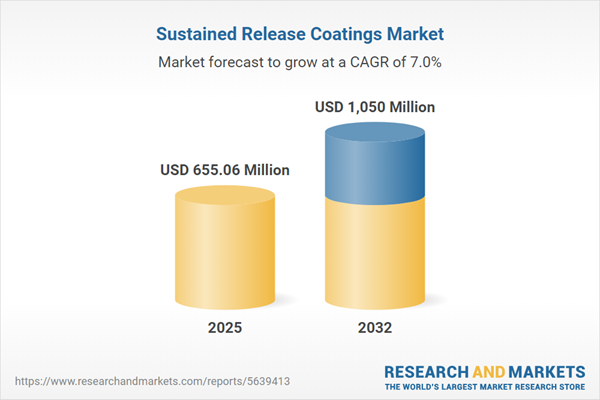Speak directly to the analyst to clarify any post sales queries you may have.
The sustained release coatings market is advancing as organizations in pharmaceuticals and nutraceuticals adopt specialized coating technologies to address operational demands, regulatory compliance, and product differentiation. Executive teams are streamlining resource allocation and strategy, positioning their companies to adjust quickly amidst evolving industry expectations.
Market Snapshot: Growth and Trends in the Sustained Release Coatings Market
Exhibiting a consistent trajectory of expansion, the global sustained release coatings market is propelled by healthcare reform and innovations in polymer technology. Senior executives across pharmaceutical and nutraceutical segments are leveraging these trends to meet rising expectations for advanced drug delivery. Sector focus on strategic partnerships is stimulating manufacturing improvements and therapeutic outcomes. The ability to modernize processing enables organizations to react swiftly to industry developments, ensuring robust competitive standing. Adoption of leading-edge coating solutions is enhancing clinical and consumer satisfaction, while enabling efficient resource management and stronger supply chains.
Sustained Release Coatings Market Scope & Segmentation
For sustained release coatings, strategic segmentation empowers leaders to build adaptive commercial strategies and position for long-term success. The market is analyzed across critical factors that influence operational choices, user experience, and compliance:
- Release Duration: Technologies deliver long-acting, medium, and short-acting options, offering flexibility in treatment strategies and supporting patient adherence across multiple therapeutic settings.
- Product Form: Solutions span capsules, coated particles, pellets, and tablets, each aligning with specific delivery requirements and optimizing logistical performance.
- Polymer Type: Key inputs such as ethyl cellulose, hydroxypropyl methylcellulose (HPMC), methacrylate copolymers, and polyvinyl alcohol (PVA) enable precise customization for various therapy scenarios and compliance mandates.
- Mechanism: Coatings employ diffusion, erosion, or osmotic approaches to achieve targeted drug delivery, empowering organizations to meet a range of clinical objectives with rigor.
- End Use: Pharmaceutical manufacturers pursue streamlined patient results and operational efficiency. Nutraceutical stakeholders drive engagement through easy-to-use dosing and focused consumer experience initiatives.
- Regional Coverage: Distinct market trends and regulatory environments in the Americas, Europe, Middle East & Africa, and Asia-Pacific influence adoption rates and growth strategies; understanding local compliance is essential for global expansion.
- Leading Companies: Major producers, including Colorcon, Inc., Evonik Industries AG, Ashland Global Holdings Inc., Shin-Etsu Chemical Co., Ltd., Roquette Frères SA, BASF SE, DuPont de Nemours, Inc., Dow Inc., The Lubrizol Corporation, and Lonza Group AG, deliver industry benchmarks in quality and innovation, driving a competitive market environment.
Sustained Release Coatings Market: Key Takeaways for Strategic Leaders
- Advances in polymer development support differentiated delivery models, strengthening patient-centric strategies and corporate reputation.
- Collaboration between manufacturing partners lowers risk, facilitates transition from research phases to commercial production, and enhances operational resilience.
- Emerging technologies establish sustained release coatings as foundational in protocols for chronic condition management and long-term therapeutic delivery, increasing sector influence on global practices.
- Recent upgrades in coating formulations—such as high-solids and solvent-free systems—are improving manufacturing efficiency and contributing toward broader sustainability objectives.
- Automation and digital monitoring improve traceability and compliance, providing executive oversight and allowing nimble responses to changing regulatory or operational demands.
- Stable, responsive supply chains are now required to navigate global market changes and shifting compliance standards, reinforcing organizational agility and resource management.
Tariff Impact: Navigating Supply Chain Adjustments
Forthcoming U.S. tariff changes projected for 2025 mean sustained release coatings manufacturers must evaluate their supply chain structures. Strengthening relationships with domestic providers and integrating new technologies will help mitigate disruption risks and address evolving regulatory requirements more effectively.
Methodology & Data Sources
This market analysis draws from executive interviews, detailed reviews of manufacturing operations, and assessment of business, scientific, and patent data sources. Statistical modeling supports reliable insights for leadership teams.
Why This Report Matters: Executive Intelligence for Decision-Makers
- Enables leaders to tackle complex operational and regulatory challenges in the sustained release coatings sector with confidence.
- Provides region-specific intelligence to inform strategic planning and risk management across diversified markets.
- Clarifies pathways for investment in advanced technologies and business partnerships, supporting future-proofed decisions as market dynamics change.
Conclusion
Sustained release coatings are instrumental for compliance and ongoing technological progress. This report assists executive teams in informed planning and prioritization as they guide their organizations in an evolving global landscape.
Additional Product Information:
- Purchase of this report includes 1 year online access with quarterly updates.
- This report can be updated on request. Please contact our Customer Experience team using the Ask a Question widget on our website.
Table of Contents
3. Executive Summary
4. Market Overview
7. Cumulative Impact of Artificial Intelligence 2025
Companies Mentioned
The companies profiled in this Sustained Release Coatings market report include:- Colorcon, Inc.
- Evonik Industries AG
- Ashland Global Holdings Inc.
- Shin-Etsu Chemical Co., Ltd.
- Roquette Frères SA
- BASF SE
- DuPont de Nemours, Inc.
- Dow Inc.
- The Lubrizol Corporation
- Lonza Group AG
Table Information
| Report Attribute | Details |
|---|---|
| No. of Pages | 187 |
| Published | November 2025 |
| Forecast Period | 2025 - 2032 |
| Estimated Market Value ( USD | $ 655.06 Million |
| Forecasted Market Value ( USD | $ 1050 Million |
| Compound Annual Growth Rate | 7.0% |
| Regions Covered | Global |
| No. of Companies Mentioned | 11 |









